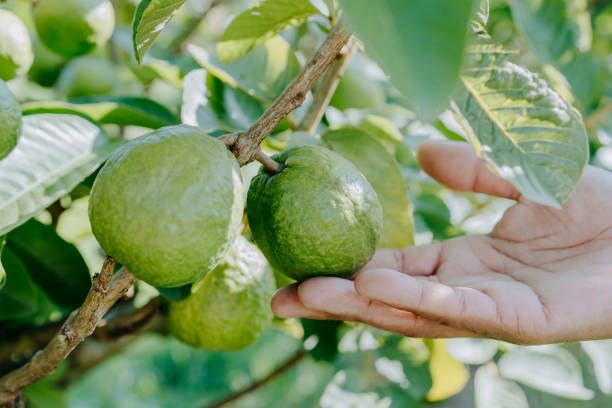In the diverse fruit landscape of India, guava trees hold a special place for their resilience, year-round sweetness, and impressive nutritional benefits. Whether you’re an urban gardener or a rural farmer, planting guava trees can be one of the most rewarding additions to your home garden or farmland. This article explores the numerous benefits of guava tree plantation in India, along with expert tips, FAQs, and comparisons with other fruit trees suited for Indian climates.
Why Guava Is Perfect for Indian Gardens
Guava (Psidium guajava), known as “Amrud” in Hindi, is a tropical fruit native to Central America but widely cultivated across India due to its adaptability. Guava trees thrive in tropical and subtropical regions, making them an ideal fit for Indian weather.
Some standout features include:
- Fast growth and fruiting within 2–4 years of planting.
- Minimal maintenance and high resistance to pests.
- Multiple harvests in a year (typically two).
Nutritional and Health Benefits of Guava
Guava is often called a “superfruit” due to its dense nutrient profile. Here’s why:
- Rich in Vitamin C: A single guava provides more than double the daily requirement of Vitamin C.
- High in fiber: Promotes digestive health and aids in weight management.
- Packed with antioxidants: Helps in fighting free radicals and reducing inflammation.
- Diabetic-friendly: Low glycemic index makes it suitable for people managing blood sugar.
Planting guava trees means growing your own supply of this incredibly healthy fruit, reducing dependency on the market while encouraging organic living.
Ideal Conditions for Growing Guava in India
Guava trees are remarkably hardy but still perform best in specific conditions:
✅ Climate:
- Thrives in warm tropical and subtropical zones
- Optimal temperature: 23°C to 35°C
- Tolerates drought and occasional frost
✅ Soil:
- Prefers well-drained loamy soil
- pH: 5.5–7.0
- Avoid waterlogged areas
✅ Sunlight:
- Requires full sun for at least 6–8 hours a day
How to Plant and Care for Guava Trees
- Planting Time
- Best planted in June–August during the monsoon or February–March for early fruiting
- Spacing
- Maintain a distance of 5–6 meters between plants
- Watering
- Young trees: Regular watering for root development
- Mature trees: Water every 7–10 days during dry spells
- Pruning
- Prune after harvesting to promote new shoots and increase fruit yield
- Fertilization
- Apply compost or farmyard manure twice a year
- Supplement with nitrogen, phosphorus, and potassium as required
Companion Trees That Complement Guava Plantations
Looking to expand your fruit garden beyond guava? Here are some top contenders that go well in Indian conditions:
- Banana Tree Wonders – Fast-growing and productive all year round
- Papaya Power – Another quick-yielding tree ideal for tropical zones
- Mango Magic – The king of fruits deserves a spot in your orchard
- Citrus at Your Doorstep – Lemon trees are perfect for backyard juicing
- Jamun Joy – A native favorite that offers medicinal value
- Pomegranate Plantation Guide – Hardy and nutrient-dense red gems
- Sapota (Chikoo) Trees – Loved for its sweet flesh and long fruiting season
- Custard Apple (Sitaphal) – Low maintenance with a unique flavor
- Coconut Tree Plantation in India – A tropical tree that offers shade and sustainability
Planting a variety of fruit trees together supports biodiversity and enhances yield through cross-pollination and soil health improvements.
Economic and Environmental Impact
✅ For Small Farmers:
- Guava trees provide a high return on investment due to frequent harvests and low maintenance.
- One hectare of guava plantation can yield 15–25 tonnes annually with proper care.
✅ For Urban Gardeners:
- Guava trees can be grown in large pots or containers for terrace gardens.
- Dwarf varieties like Lucknow-49 are ideal for limited spaces.
✅ For the Environment:
- Guava trees support soil conservation and improve air quality.
- Their dense foliage provides shelter for birds and insects, contributing to the local ecosystem.
FAQs About Planting Guava Trees in India
Q1: Which guava variety is best for Indian climates? Lucknow-49, Allahabad Safeda, and Arka Mridula are popular choices for high yield and sweetness.
Q2: Can I grow guava in pots? Yes, choose dwarf varieties and ensure proper pruning and container size (at least 18 inches in diameter).
Q3: How long does it take for a guava tree to bear fruit? Generally, 2–4 years from planting, though grafted varieties may fruit earlier.
Q4: What pests affect guava trees? Fruit flies, mealybugs, and aphids are common. Use neem-based organic sprays or insect traps as preventive measures.
Q5: How often should I fertilize guava trees? Fertilize twice a year – once before flowering and again after harvesting. Add compost, nitrogen, and potash.
Final Thoughts
Planting guava trees is more than just growing fruit — it’s about cultivating a healthier lifestyle, supporting the environment, and enjoying the simple joys of harvesting your own sweetness. Whether you live in a rural village or a city apartment, there’s a guava variety and growing method suited just for you.
If you’re serious about growing your own fruit paradise, don’t stop at guava. Consider exploring banana trees, mango plantations, or even lemon trees to round out your home orchard.
